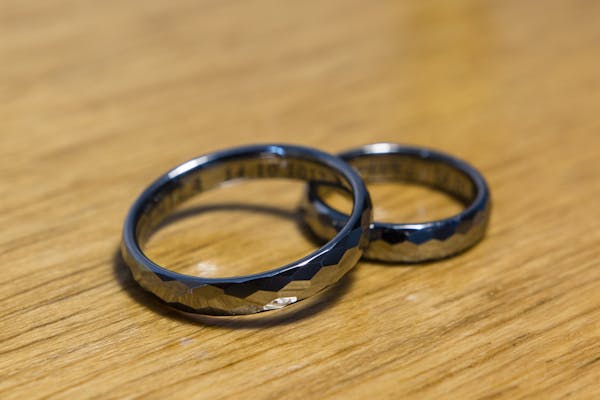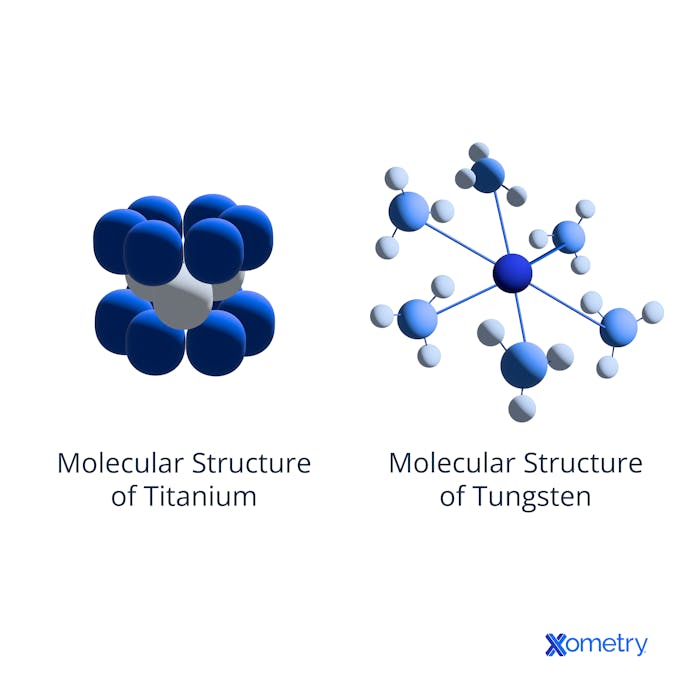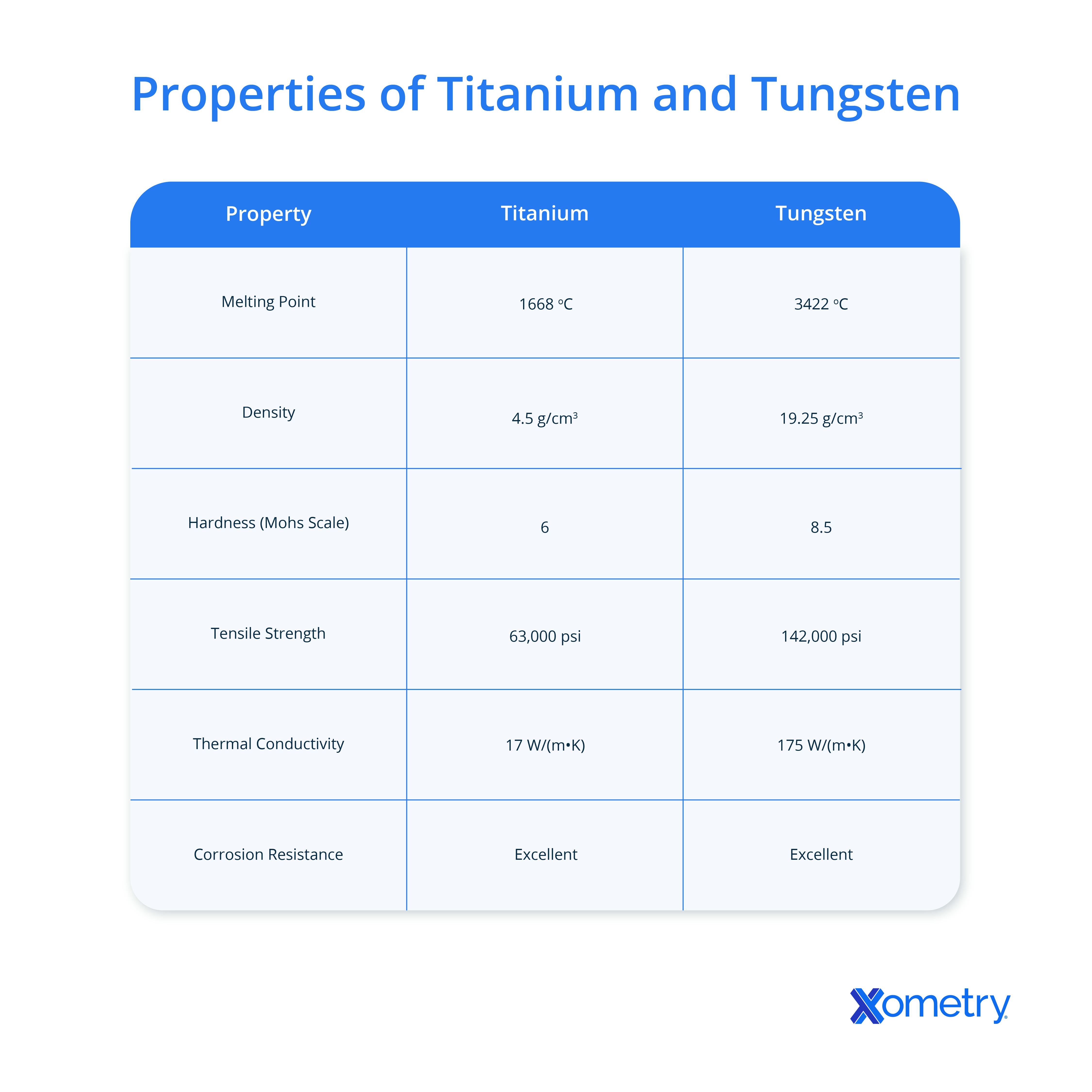Both titanium and tungsten are important materials in everything from the world of jewelry to industrial settings. Titanium has hypoallergenic qualities, in addition to being corrosion-resistant and lightweight, which makes it popular among Xometry aerospace customers. Tungsten, though, is exceptionally hard, scratch-resistant, and extremely dense, which makes it useful in other applications.
Though they can both look rather similar, they differ significantly in their weights and compositions. These differences will be discussed in this article, which will be especially useful if you want to choose between the two for things like rings. We’ll also look at some of their applications, advantages, and disadvantages.
What is Titanium?
Sometimes called Gregorite (from the Reverend William Gregor who discovered it in Cornwall, England, in 1971), Titanium (Ti) is a transition metal with a unique silvery-white exterior. It’s only found in nature as an oxide, and in its purest form of titanium, it’s already corrosion-resistant and strong. It’s also water resistant, but in the presence of concentrated acids, it will dissolve. For these reasons, titanium is pretty much used everywhere, from the aerospace to the medical sectors.
Titanium is most often CNC machined from stock into various components, but it is also possible to 3D print parts from it using our DMLS process. As it’s only found as an oxide in nature, titanium needs to be processed and refined into the usable forms we are familiar with. That’s where the Kroll method comes in, which involves extracting minerals like rutile, ilmenite, or sphene and purifying them.
Titanium concentrates are processed with carbon and chlorine gas to get impure titanium tetrachloride. Then the titanium tetrachloride is purified and distilled in order to separate the contaminants. The refined liquid is then combined with magnesium to create a sort of porous titanium sponge which is further treated in an arc furnace to turn it into a titanium alloy. Once you’ve checked the freshly made ingot, it will then be sent for further treatment to make it suitable for the intended application. It can later be laser cut into various shapes, which Xometry can help you with.

| Type | Description |
|---|---|
Type Ti 6Al-4V (Grade 5) | Description This is the strongest titanium alloy and is commonly used in aerospace, medical, and marine applications |
Type Ti 6Al-4V ELI (Grade 23) | Description Known as surgical titanium, Grade 23 is malleable and corrosion-resistant, and used in medical and dental |
Type Ti 3Al 2.5 (Grade 9) | Description Grade 9 has a high-temperature strength, and is used a lot in manufacturing, chemical, and marine |
Type Ti 5Al-2.5Sn (Grade 6) | Description Grade 6 is non-heat-treatable, but has impressive weldability, stability, and strength. It’s used for aircraft and airframe components |
| Advantages | Disadvantages |
|---|---|
Advantages Forms a layer of titanium dioxide that protects it from rust and corrosion | Disadvantages It’s usually more expensive than other commonly used metals, like aluminum or steel |
Advantages Is 100% recyclable, reducing waste | Disadvantages It’s not the easiest to get, and can be hard to access. Might not work well for those who need a lot of it and quickly |
Advantages Roughly half the weight of steel, but just as strong, it’s ideal for lightweight yet sturdy structures | Disadvantages Titanium is not as easy to cast as iron or aluminum |
Advantages Has the highest strength-to-density ratio among metals, which is why it’s a hit in aerospace manufacturing | Disadvantages Its high melting temperature and reactivity makes titanium a more difficult metal to weld |
Titanium: Advantages vs. Disadvantages
What is Tungsten?
Tungsten (W), also known as Wolfram, is a strong, silvery-white metal that was discovered in 1783 by Spanish chemists Juan José and Fausto Elhuyar. It’s refractory, meaning it's highly wear- and heat-resistant. This rare metal is mostly found in compounds with other elements. If pure tungsten were to be coarsely powdered, it could ignite on its own and catch fire. Steel is often alloyed with tungsten to increase its hardness and strength, and quite often, lightbulb filaments will be made from tungsten. Other common items that might be made from it include the cutting tools our shops utilize for machining parts, jewelry, and radiation shielding. To get an idea of what tungsten looks like in the real world, here is an image of some jewelry made out of the metal.

Just like titanium, you won’t be able to find any tungsten in its pure form in nature. To get it, it has to be extracted and produced from minerals; wolframite and scheelite are the two main sources. To get to these minerals, a couple of mining methods are used; surface mining (removing the rock and soil above the mineral), and underground mining (via shafts and tunnels). The ores are crushed and cleaned, then treated with alkali to make tungsten trioxide (WO3). Carbon or hydrogen gas is then used to heat the compound and produce tungsten metal with carbon dioxide or water vapor.
Different Types of Tungsten
If you’ve ever come across tungsten, it’s highly likely it was tungsten carbide. This is the most popular type and is used in many tools, thanks to its strength and chemical resistance. There are lots of other types, too, like cemented carbide, heavy metal tungsten alloys, pure tungsten, and alloyed tungsten. Cobalt-alloyed cemented carbide is popular among Xometry customers for equipment like industrial pumps, cutting tools, and mining equipment. Tungsten is often used in its pure form in electrical applications, and tungsten-based chemicals can often be found in things like ceramics and pigments.
Tungsten: Advantages vs. Disadvantages
In the hope of giving you further insight into tungsten, we’ve broken down its key advantages and disadvantages below:
| Advantages | Disadvantages |
|---|---|
Advantages It’s ideal for racing car ballast, alloys, and other compact yet weighty applications | Disadvantages It’s difficult to cut, drill, and weld |
Advantages Helps tools remain stable in extreme heat conditions | Disadvantages Pricier than zinc alloy, stainless steel, and titanium |
Advantages Perfect for corrosive environments like marine applications | Disadvantages Its high melting point can complicate the fabrication process |
Advantages Very high melting point | Disadvantages It can crack or shatter on impact |
Advantages Can be used in X-ray targets, radiation shielding, and electronic components | Disadvantages Rings made from tungsten can’t be resized |
Tungsten: Advantages vs. Disadvantages
Titanium vs. Tungsten: How to Choose
Xometry customers often ask whether titanium or tungsten would be better suited to their projects. Once we collect all the important information, such as their precise needs, preferences, part geometry, and their part's intended function, we are in a better position to advise them. For instance, for customers who want to make a strong and scratch-resistant item, we recommend tungsten. If impact resistance isn’t a concern, this is a good choice, but if it could get knocked about a bit, perhaps it won’t be suitable, as tungsten tends to be brittle. In this instance, titanium could be a good compromise as it’s strong (albeit not as much as tungsten), corrosion-resistant, and lightweight. Tungsten's 142,000 psi tensile strength is stronger than titanium's 63,000 psi, but titanium has a better mix of strength and lightweightness. The image below shows the molecular structures of titanium and tungsten.


| Comparisons | Titanium | Tungsten |
|---|---|---|
Comparisons Suitable for arc welding | Titanium Yes | Tungsten Yes |
Comparisons Scratch-resistant | Titanium Yes | Tungsten Yes (slightly more) |
Comparisons Crack-resistant | Titanium Yes (slightly more) | Tungsten Yes |
Comparisons General cost (can vary) | Titanium $0.35 per pound | Tungsten $3.25 per pound |
Comparisons Identification mark | Titanium Lower density and lightweight | Tungsten High density and heavier |
Comparisons Common Applications | Titanium Aerospace Components, Medical Implants,
Sports Gear, Jewelry | Tungsten Lightbulb Illumination, Cutting Tools, Microelectronics, Radiation Shielding, Jewelry |
Comparisons Suitable for shipbuilding | Titanium Yes | Tungsten No |
Comparing Titanium and Tungsten
How Xometry Can Help
Xometry offers comprehensive manufacturing solutions for titanium or tungsten needs and makes quoting super easy. With a focus on on-demand precise manufacturing, Xometry offers a range of services, including CNC machining processes like milling and turning. For titanium, we also offer sheet cutting and bending services. If you have any questions on either titanium or tungsten, want tips on how to best use this material, or know exactly what you want and need a free quote, a Xometry representative is waiting to hear from you!
Disclaimer
The content appearing on this webpage is for informational purposes only. Xometry makes no representation or warranty of any kind, be it expressed or implied, as to the accuracy, completeness, or validity of the information. Any performance parameters, geometric tolerances, specific design features, quality and types of materials, or processes should not be inferred to represent what will be delivered by third-party suppliers or manufacturers through Xometry’s network. Buyers seeking quotes for parts are responsible for defining the specific requirements for those parts. Please refer to our terms and conditions for more information.


